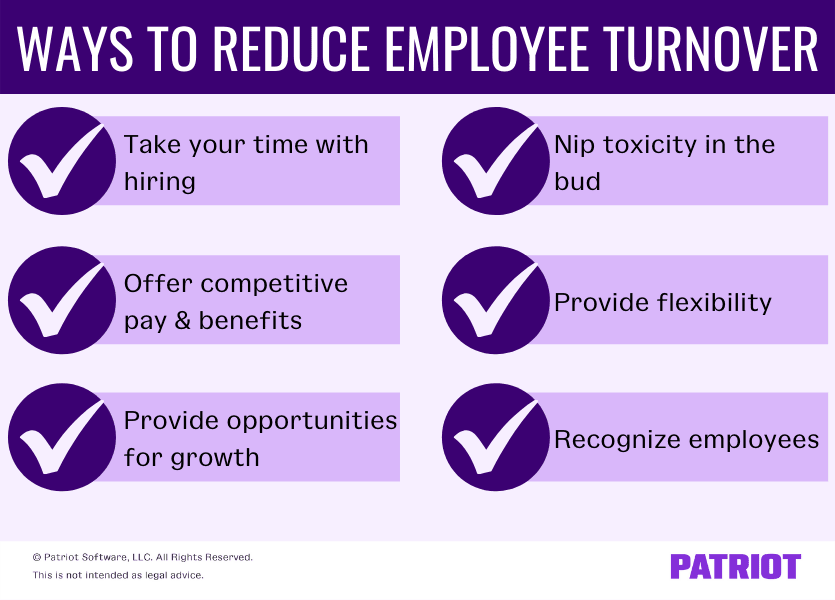Here’s a sad truth: Employees come and go. Why? Turnover is a fact of life as a business owner. Staff retention can be a hot-button issue in your company if you have a high turnover rate. And if it’s starting to feel like there’s a revolving door for staff members, it’s time to look at some ways to reduce employee turnover.
6 Ways to reduce employee turnover
Employee turnover is an expensive process. You spend money to post a position, take time to interview, use time and money to train a new employee, and then start all over again if an employee leaves.
According to the Bureau of Labor Statistics (BLS), 32.7% of all total job separations in 2021 were from employees quitting. The private sector saw a whopping staff turnover rate of 57.3%, though the average depends on the industry and location. With information like this, you could expect a high turnover. Take a look at six ways to reduce employee turnover in your company.

1. Take your time with hiring
Hiring employees can be exciting, but it’s also a time-consuming process. And, you have to be sure you’re making the right decision about which candidate you hire. That’s why it’s so important to take your time with the hiring process.
Clearly define the roles and responsibilities in the job description to ensure all candidates understand what they would be expected to do. Highlight the qualifications required from applicants, describe the work environment, and detail the perks of working for your business.
As applications come through, carefully evaluate each candidate and how their qualifications match the requirements in your job description. Filter through and consider scheduling phone interviews to further narrow down your decision.
In the interview process, choose questions that directly speak to the job description requirements. Ask for examples of how the candidates have accomplished similar tasks in their prior roles. And, take notes during the interview to look back on when making your decision later.
Taking your time to hire the right candidate can help ensure you’re not making a rushed decision. By not rushing through the process, you’re more likely to find a new employee who will be happy to stay with your company longer.
2. Offer competitive compensation and benefits
One survey reported that as many as 90% of employees want health insurance benefits, and as many as 55% want retirement. The pay and benefits employees receive encourage individuals to apply for work with your business and can help to keep them.
Consider using the BLS website to research salaries and benefits in your industry and area. Underpaying employees can lead to them leaving for a position with higher wages and better benefits. By using BLS statistics, you can better understand competitive wages for your employees.
3. Provide opportunities for growth
The longer an employee stays with a company, the more comfortable and familiar they become with their role. Although comfort and familiarity can be good, you may see employees leave to seek more challenging opportunities or grow as workers.
To combat an employee turnover rate related to employees seeking new challenges, consider:
- Training courses
- Clear employee advancement ladders
- Mentoring opportunities
- Opportunities to get out of their comfort zone
- Open-door policies to foster a positive work environment
- Seeking out feedback from employees
When your workers are engaged with their work, they feel like they can be challenged and grow. And if an employee comes to you with their own ideas for growth, sit down and discuss with them. You may not be able to implement all of their ideas, but listening can help you determine how to help them feel more involved and challenged.
Want to be the friend that’s always in the know?
Get the latest small business news delivered straight to your inbox.
Subscribe to Email List4. Nip toxicity in the bud
Toxicity in the workplace can spread until all of your best employees are looking for a way out. Don’t let that happen to your business. If you start to notice any signs of a toxic workplace, make a conscious effort to squash it.
If you have an open-door policy or encourage open communication, continue to do so. Give your employees the opportunity to come to you with any problems they may have. And, make positive changes that impact the whole workplace, if necessary.
Too much gossip in the office? Create a zero-tolerance policy and stick to it. Does communication seem to be lacking? Have daily meetings and provide your workers with plenty of opportunities to communicate with each other.
5. Provide flexibility
Let’s face it: COVID-19 brought about a boom in work-from-home opportunities. One survey said that a whopping 58% of employees would look for a new job if they could not continue working remotely. And, 79% of people would be more loyal to their employers if they had more flexibility.
Flexibility with work locations may not always be a choice. For example, a hotel concierge generally needs to be behind the desk in the hotel lobby to perform their essential work duties. But, that doesn’t mean you can’t be flexible in other areas. Consider other forms of flex time, if possible.
As part of being flexible with your employees, encourage a work-life balance. Doing so can decrease employee burnout that leaves workers looking for a new role. A work-life balance can mean offering paid time off and encouraging its use, having a strict end to a workday or workweek (e.g., no working weekends), or mandatory time off policies.
6. Recognize employees for their work
Everyone likes to feel appreciated and that the work they do matters. Recognize your employees’ contributions to help them see the work they do is important to your business.
There are a few ways you can recognize your employees, including:
- Thank you notes
- Messages of appreciation
- Employee of the month standings
- Providing new opportunities
- Peer-to-peer recognition systems
- One-on-one meetings with employees each week
Feedback has an impact—a positive one. Employees who feel appreciated and recognized respond better to challenges and seek to learn more. By encouraging employees through recognition, you can reduce your turnover rate.
This is not intended as legal advice; for more information, please click here.
